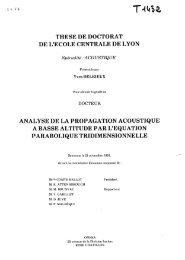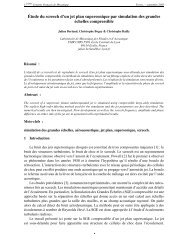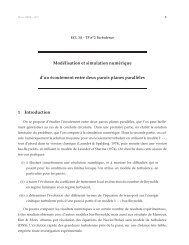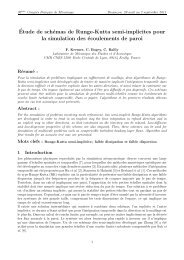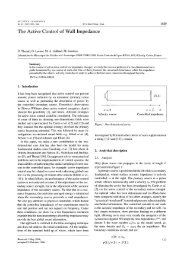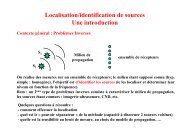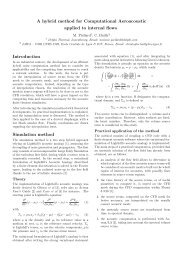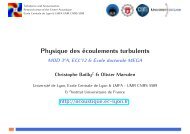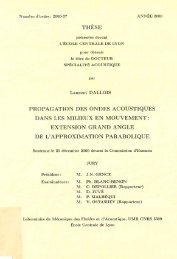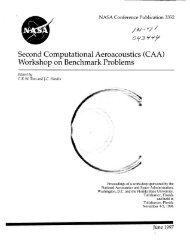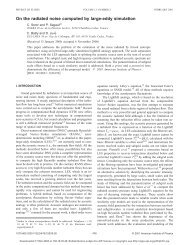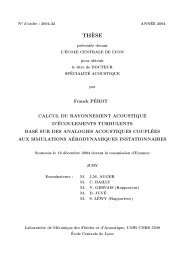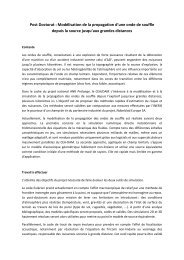ERCOFTAC Bulletin - Centre Acoustique
ERCOFTAC Bulletin - Centre Acoustique
ERCOFTAC Bulletin - Centre Acoustique
You also want an ePaper? Increase the reach of your titles
YUMPU automatically turns print PDFs into web optimized ePapers that Google loves.
2.8 Filtering<br />
The acoustic sources are usually given with a fine spatial<br />
resolution on the grid of the flow simulation, while<br />
the acoustic propagation allows a coarser grid. This can<br />
cause aliasing effects, which lead to serious stability problems<br />
in the acoustic simulation. Spatial filtering is a suitable<br />
method to avoid this problem. In the presented calculation<br />
a modal filter, as presented by Hesthaven [11],<br />
was used. The basic idea is to eliminate the small scale<br />
disturbances which can not be accurately resolved on the<br />
coarser grid, by reducing the influence of the high order<br />
modes:<br />
u filtered<br />
i = αi ui ∀ i = 1 . . . nDegF r (10)<br />
The filter coefficients depend on the space order to which<br />
the degrees of freedom i are related (see Table (1)). It<br />
iDegF r 1 2 ... 3 4 ... 6 7 ... 10<br />
αi 1.0000 0.9995 0.8688 0.0272<br />
Table 1: Coefficients of modal filter for p = 3, nDegF r =<br />
10<br />
has to be made sure that the coefficient for the first degree<br />
of freedom, which is the cell mean value, is equal<br />
to one to ensure the conservation property of the filter.<br />
For the presented calculations the filter was applied to<br />
k u(tn) after each Taylor-DG step.<br />
∂<br />
∂t<br />
3 The hybrid grid scheme -<br />
PIANO+<br />
As stated before, unstructured grids are very suitable<br />
for simulations in complex shaped domains due to their<br />
straightforward mesh generation. However, in the far<br />
field the generation of structured grids is comparably<br />
easy. Hence, it is favourable to benefit from the advantages<br />
of structured solvers in terms of memory demand,<br />
grid handling effort and visualization. This led to the<br />
idea of coupling schemes for those different grid types.<br />
These were the presented solver NoisSol and the finitedifference<br />
(FD) solver PIANO (Perturbation Investigation<br />
of Aerodynamic Noise [10]).<br />
For the hybrid computation the computational domain<br />
is splitted such, that both programs work on nonoverlapping<br />
grids with straight coupling interfaces. The<br />
information of the coupling partner are included using<br />
ghost cells (DG) or ghost points (FD). There the continuity<br />
of the primitive variables is enforced, which proved<br />
to be the best way to prevent artificial reflections at the<br />
interface. The data exchange is done by an extension of<br />
the MPI infrastructure, that was already implemented<br />
in both solvers.<br />
The main focus in this coupling framework was on the<br />
automatization of the coupling process to make it applicable<br />
for industrial applications. For detailed information<br />
about the coupled scheme see [8].<br />
4 Application to airfoil noise - the<br />
NASA 30P30N test case<br />
One topic that is of great interest for computational<br />
aeroacoustic applications in aerospace sciences is the<br />
noise generation of an airfoil in high-lift configuration,<br />
i.e., with deployed slat and flap.<br />
This application is also a demanding test case for<br />
acoustic simulation programs, since it combines a very<br />
inhomogeneous flow, a complex geometry and many different<br />
noise generation mechanisms. In this application<br />
a three part airfoil is examined, which was described<br />
by Lockard and Choudhari in 2009 [4]. The calculation<br />
presented here bases on a RANS computation for an<br />
unswept wing with an angle of attack of 4 ◦ , a Mach<br />
number of 0.17 and a Reynolds number of 1.7e6. Based<br />
on this flow field sound sources in 2D were calculated<br />
by Roland Ewert of the IAS at the German Aerospace<br />
Center (DLR) applying their Fast Random Particle<br />
Mesh (FRPM) method [6]. The source calculation was<br />
limited to a rectangular region around the slat trailing<br />
edge (see Figure (1)).<br />
The mean flow values have also been taken from the<br />
RANS calculation.<br />
The acoustic simulations were performed with the<br />
Acoustic Perturbation Equations (APE), type 4 , see<br />
Ewert and Schröder [7]. The space and time order<br />
of the scheme were set to 4, the time step became<br />
3.45e-5 in both cases. For the uncoupled simulation a<br />
Figure 1: Setup NASA 30P30N (Arrow points to center<br />
of microphone circle.)<br />
circular domain with a radius of 3.5 around the origin<br />
was used. For the coupled computation 4 NoisSol<br />
processes and 4 PIANO processes with 4 blocks each<br />
were combined. The grid setup is shown in Figure (2).<br />
Figure (3) shows a good qualitative agreement between<br />
Figure 2: Grid setup for coupled computation<br />
the frequency spectra of the here presented calculations<br />
and the reference solution by Lockhard [5]. Also the<br />
pressure fields, Figure (4) and Figure (5), agree very well.<br />
Table (2) shows a comparison of the computation<br />
times, where tsim is the dimensionless simulated time<br />
and tCP U the CPU time in hours. The uncoupled<br />
computation has been performed on a cluster with<br />
Intel Xeon Nehalem 2.8 GHz CPUs. For the coupled<br />
computation an AMD-Opteron equipped cluster with<br />
2.4 GHz has been used.<br />
A conclusion can not be derived straightforward<br />
from these results. Motivated by the strong decay<br />
of NoisSol’s performance some additional test runs<br />
<strong>ERCOFTAC</strong> <strong>Bulletin</strong> 90 31



